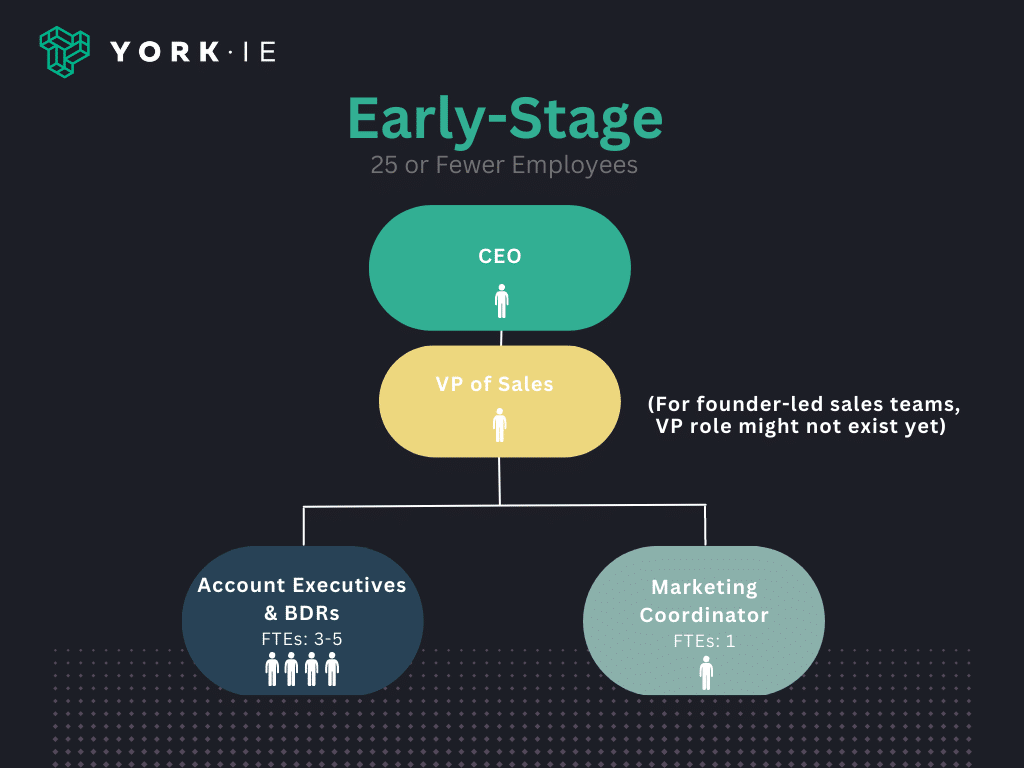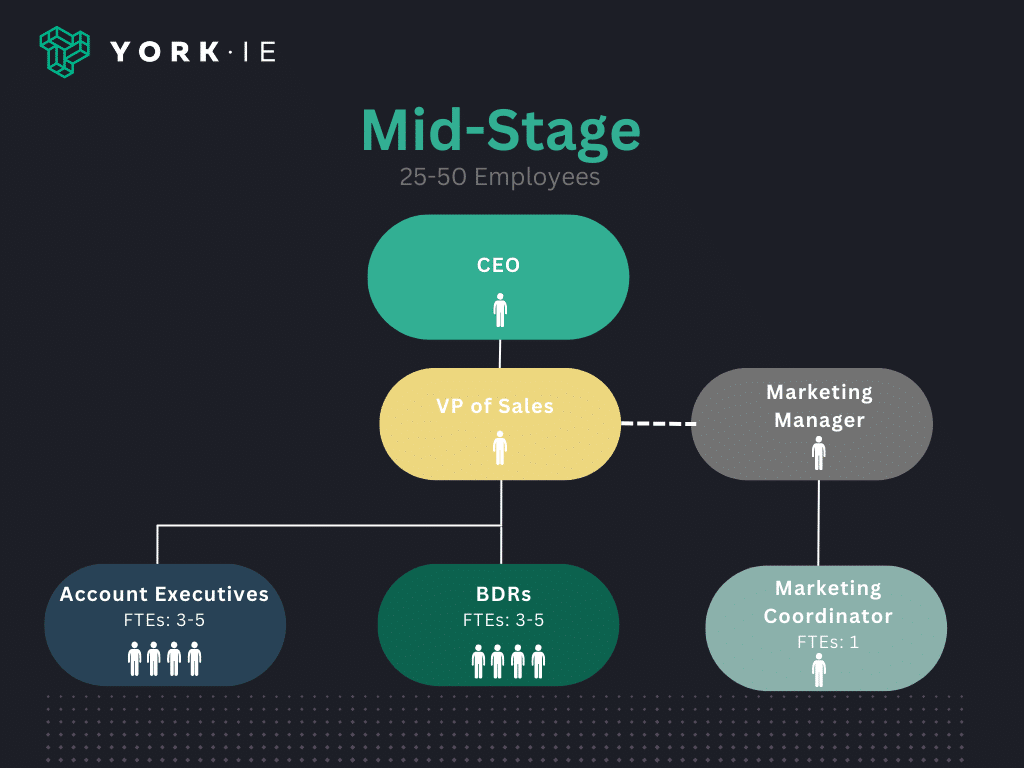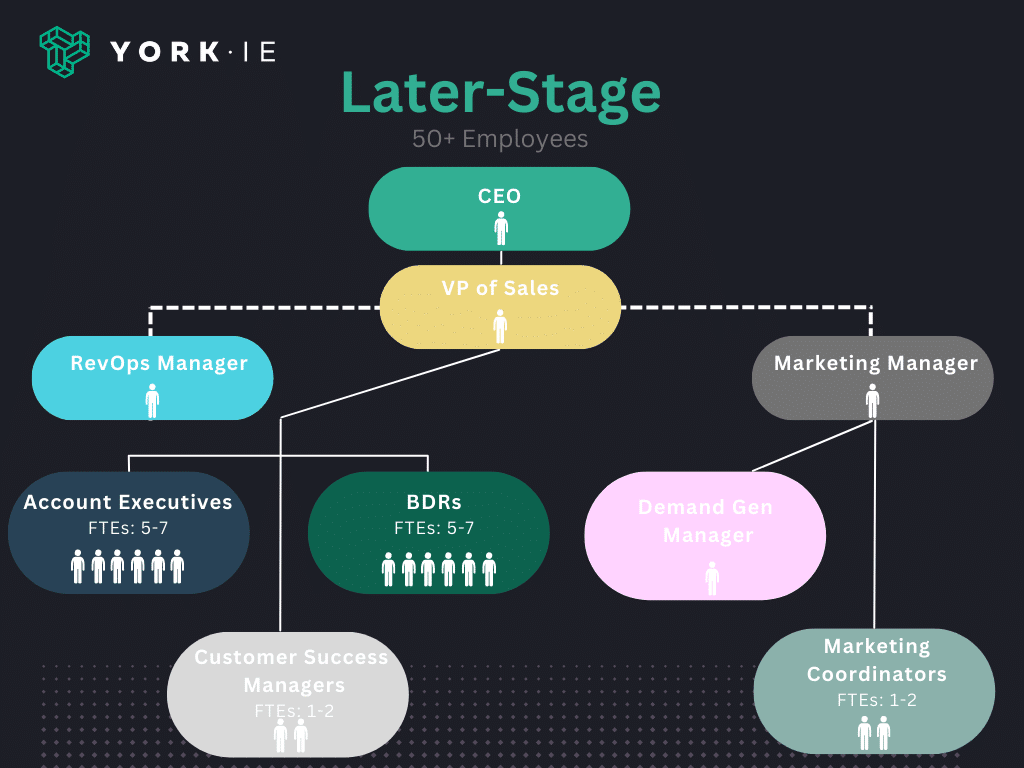Your sales team structure is crucial to the success of your GTM strategy. Effectively structuring your sales org enables you to get the most out of each employee and unify the team toward your ultimate goal: driving revenue.
Over the past 15 years, I’ve been a part of sales orgs of various sizes across the B2B software world. I’ve also helped many of York IE’s Advisory as a Service clients structure their sales teams.
What I’ve learned is that each company is unique; your sales organization chart will look different depending on your product, go-to-market (GTM) strategy and end goals. What’s most important though, is finding a structure that works for your company — one that unlocks your sales team’s potential by aligning their priorities and supporting them with the right resources.
Let’s explore the makings of an effective sales organization structure in this blog post. You’ll also be able to download a sales team structure template.
Table of Contents
- What Is a Good Sales Structure?
- 3 Types of Sales Team Structures
- Sales Organization Chart Examples
- Sales Team Structure Template
What Is a Good Sales Structure?
A good sales team structure should create clearly defined roles for your salespeople and marketers, with prioritized resources allocated to each role. Your specific structure will depend on the size of your team and your company’s specific go-to-market motion (founder-led, product-led or sales-led growth).
Clearly Defined Roles
Sales organizations work best when each member knows exactly what they’re supposed to do. This allows every team member to focus on the highest-value activities for their role, rather than being distracted by a disjointed set of daily responsibilities.
A well-defined sales organization chart lets each employee know who they report to and who they oversee. Everyone knows where they stand and understands their compensation plans so they can channel their energy into their work.
Resource Prioritization
According to Data Dwell, 65% of sales managers said a lack of resources and time is their biggest barrier to closing more deals. The right sales department structure can help you use your company’s limited time and resources most efficiently.
Growing tech companies — especially those in the early stages — have to be lean, nimble and efficient. It’d be great if you could hire a full team of sales, marketing and customer service reps the day after you incorporate. But for most, that’s not realistic.
Mapping out your org structure helps you build an effective hiring plan. Hire for the most crucial positions first, then fill in the supporting roles after. For example, you’ll likely hire a sales leader before a customer service leader; you need to have customers before you focus on delivering excellent support.
A Foundation for Sustainable Growth
Growing revenue is a lot easier when you’ve clearly defined each person’s role and efficiently allocated your resources. By putting the right people in the right positions, you’ll feel confident that each employee is contributing towards your revenue goals. You’ll also know which key positions are next in your hiring plan. Lastly, having a clearly defined org structure will show employees a career path within your company as you grow.
3 Types of Sales Team Structures
Here are three common examples of sales team structure:
- founder-led growth;
- product-led growth; and
- sales-led growth.
Founder-Led Growth
Founder-led growth is most common in early-stage companies. This model only works if your founder or CEO has a strong sales background.
As the name suggests, a founder-led sales organization relies on a founder to generate deals with customers. This founder likely has a large network of industry contacts they can tap into. At the earliest stages, a founder might handle the entire sales motion from prospecting to closing.
As you grow, the founder should hire a sales leader, account executive (AE) or business development representative (BDR) to help generate leads and/or close deals. Once you achieve a certain level of growth (and have a more established sales team), the founder should step back from the sales process and focus only on strategic accounts.
Sales-Led Growth
Understanding your GTM strategy is an important part of designing your sales team structure. Most companies rely on a sales-led model, in which a company uses its sales team to generate leads and drive conversions.
Traditionally, founders will hire a chief revenue officer (CRO) or vice president of sales to lead the sales org. Underneath this sales leader will be AEs, who are responsible for closing deals and upselling existing accounts. Also included are BDRs, who typically generate leads and book meetings with qualified prospects before passing them off to AEs.
Product-Led Growth
Some companies are proponents of product-led growth (PLG), in which they create a pipeline of users through a self-service offering (often for free) before upselling customers into a paid model.
PLG isn’t right for every company, but big names such as Slack, Dropbox and Notion have found success. For companies such as these, the sales team will focus more on reaching out to existing accounts, rather than generating new leads. That means you’ll likely have more account managers or customer success managers than traditional AEs.
In some cases, a product-led company may scale its marketing team first to generate brand awareness and drive free users. Titles such as community manager and product marketing manager will be more prevalent.
Sales Organization Chart Examples
Every company’s sales organization chart is likely a little different. We’ve compiled three examples, based on stages of company growth:
Early-Stage: 25 or Fewer Employees
At the earliest stages, your sales org will be quite small. You’ll typically hire three to five salespeople — a mix of BDRs and AEs — that all report to the vice president of sales. If your founder or CEO has a sales-oriented background, they might lead the sales org in lieu of a VP-level hire.
The VP of sales is overseeing everything: sales quotas, marketing leads, etc. Eventually, their role will shift from execution to strategy and management.
Mid-Stage: 25-50 Employees
Now that you’ve got some traction and started generating revenue, your sales organization has grown significantly. The founder/CEO has hopefully taken a step back to focus on running the entire company. BDRs are booking meetings and AEs are closing deals. The VP of sales is spending time with some strategic accounts but is now more focused on keeping AEs and BDRs accountable to their goals.
On the marketing side, you’ve hired a marketing manager to spearhead your efforts. You’ve begun to add employees — such as a marketing coordinator —- that help with lead generation and brand awareness.
Later-Stage: 50+ Employees
As you continue to grow, the sales department structure is becoming more specialized. Companies at this stage have brought on a significant number of BDRs and AEs and begun growing a customer success department, which sits under the vice president of sales. A larger marketing presence is required, and you can now begin building out a more formal marketing team. More specialized professionals such as a RevOps manager or demand generation manager can help you lay the foundation for continued growth.
Sales Team Structure Template
Organizing your sales team is a great way to increase efficiency, alignment, employee satisfaction and, of course, revenue. How you structure your sales department depends on your GTM strategy and company goals. Download our sales team structure template to set a foundation for strategic growth.










